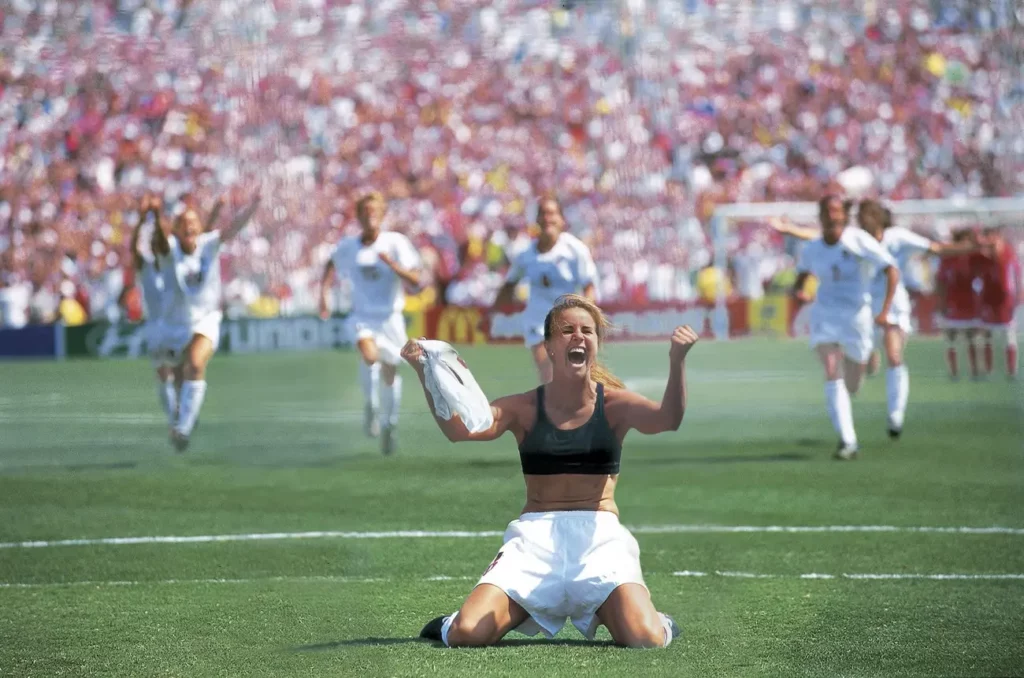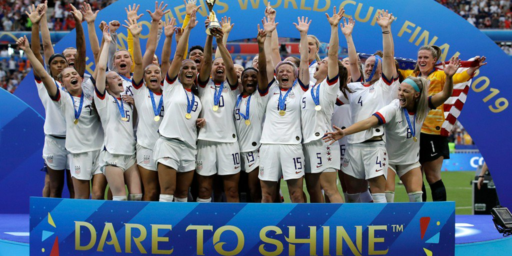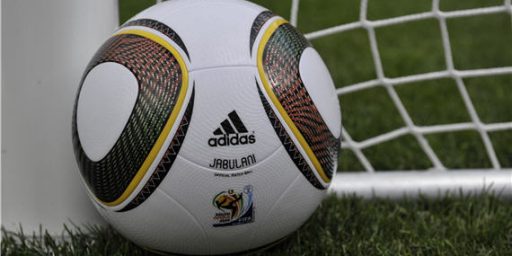The World Is Catching Up
Americans have taken the dominance of the Women's National Team for granted.

The Atlantic’s Franklin Foer reflects on “The End of the U.S. Women’s Soccer Dominance,” concluding that it’s actually a very good thing.
For those not paying attention, the team, which won the first Women’s World Cup in 1991 and has won four of the eight previous iterations and has never finished outside the top three, barely qualified for the knockout round in this tournament (albeit from a ridiculously tough group that featured the two finalists from the 2019 Cup). If they don’t get much better, fast, they’ll lose to Sweden Sunday.
If the U.S. no longer has its mantle, that is because other countries have swiped it. Brazil, England, Spain, and even Colombia have stitched together performances at this World Cup that have exuded old-fashioned American imperiousness. These performances aren’t anomalous. The global women’s game is in the middle of a revolution, whereby its underlying economics are rapidly changing. For generations, American women have flourished because of their country’s unique sporting culture. This tournament, however, has made evident that the virtues of that model are becoming outmoded.
So much of the historic success of the U.S. women’s team is tethered to a noble piece of legislation: Title IX, a 1972 amendment to the Higher Education Act, requiring federally funded universities to treat male and female athletes as equal. This was, indeed, American exceptionalism. The U.S. was one of the few countries that, in nearly every sport, exploited college as a primary pipeline for developing professional athletes regardless of gender. The American university system went on to produce a wide pool of female soccer talent, as it supplied the best coaching in the world at the time. Young women around the globe who wanted to overcome the misogyny of soccer culture in their home country found the best opportunities in places like the University of North Carolina or Stanford.
But, long story short, this advantage hasn’t translated into a women’s professional league with a huge following. The game is wildly more popular just about everywhere else and, while they were slow to grasp that fans would watch women’s soccer, once they did they were able to glom onto the infrastructure and fan bases of the men’s leagues.
In most crucial ways, European women’s squads still receive second-class treatment—women are paid a fraction of what the men are, and they are forced to play on inferior fields—but a growth trajectory is visible. Last year, Barcelona’s and Real Madrid’s women’s teams squared off in front of 91,000 fans. The final of the Women’s Champions League, in the Netherlands, sold out the 34,000-seat stadium. There are rarely moments in the U.S. women’s professional league that can quite match this scale.
The investment in the European game is visible on the pitch too. Players join club-run academies at young ages, where they receive superior coaching—a higher level of technical skills and tactical awareness—to what they’d find in the United States. (The most technically gifted player in this year’s World Cup is the Spanish midfielder Aitana Bonmatí, a product of the Barcelona youth setup.) And the game is not just the province of upper-middle-class families, who, in America, might pay thousands of dollars to youth soccer clubs in the hopes that their kid might win a precious place at an elite university. Perhaps the ultimate acknowledgement of an emerging European superiority is that American clubs have begun edging toward its model. Both the Portland Thorns and the Washington Spirit, in the National Women’s Soccer League, have given contracts to 15-year-old players, bypassing the old collegiate system.
In a way, the development of the global game is the inevitable, self-defeating by-product of America’s idealism in women’s soccer. The U.S. Women’s National Team always presented itself as a city on a hill, a beacon of what happens when girls are given access to the same resources as boys. For years, it rightfully claimed to be battling the entrenched misogyny of the game’s overlords. At this World Cup, the mediocre results of the team so far might actually reflect one of their greatest victories after all.
The USWNT faces the same conundrum as the US Men’s Basketball Team: anything less than winning it all is viewed as a failure. They won the inaugural cup in 1991 won again in 1999, 2015, and 2019.
But Foer is right: while National Women’s Soccer League, now on hiatus from its eleventh season, is easily the most successful attempt at a women’s pro league, it’s still a relatively niche league here. Even the men’s league, Major League Soccer, is considered a third-tier league; indeed, more Americans watch the English Premier League.
Beyond that, we have a wildly different youth sport culture here than just about anywhere else in the world. There just isn’t anything like the academy system here, for good or ill. That the pathway to elite status in most sports are travel leagues available only to those whose parents can afford it and are willing to get on board with the daily grind certainly complicates matters considerably.






My daughter and her girlfriend are huge fans of Gotham, the women’s soccer league in NJ/NY. The fan community is small, but fantastic. Simlilarly, when our kids were little, as a family we attended a number of men’s league Metro Stars (now Red Bulls) games. It is such a different experience being fans of a not-so-popular sport. There is a lot more interaction with the players and the team. Autographs, players and coaches showing up at events, promotion with kids leagues, opportunities for kids to go on field in the stadium, all of these things are a pleasure at the less-popular level, not to mention the lack of egos and drama. Merch and food/drinks at the stadium are cheaper. You don’t get the constant barrage of things to separate cash from your wallet. Overall just a much more pleasant experience.
Nothing last forever. All the great dominant runs in sports come to an end. But let’s not write an epitath for the USWNT while they are still alive and kicking.
No matter what happens this weekend, these women should be proud of their achievements. Like US track & field, men’s and women’s basketball, and women’s gymnastics, I think women’s soccer will remain an ongoing source of national pride. Of course they can’t all win every contest.
This article touches on something I have been wondering about. I have heard a lot of talk about “US women’s soccer players don’t take as much money, even though they are champions” which always raised the question in my mind as to whether they were actually a great team or it there was not really any competition. This article makes me think it’s the latter.
Meanwhile, over at Jezebel, considering biological reasons that women soccer players might be more prone to ACL injury is sexist. https://jezebel.com/womens-world-cup-acl-knee-tear-injury-uswnt-fifa-1850700454
I passionately follow two teams in the English pyramid: Wrexham and Manchester United. I follow these two teams like a Green Bay Packers or Pittsburgh Steelers fan follows their team. As such, I also follow their women’s teams, and have noticed to uptick in the quality of the futbol matching increased fans, and increased exposure in terms of better and bigger sponsors.
Last season, Wrexham’s woman’s team played their final match before 10,000 fans at the Racecorse (their home field). This is non-league, semi-professional, WOMAN’S soccer, and they drew 10K on a windy, cloudy, cold day in North Wales.
I was surprised Carli Lloyd got so much grief the last few days for pointing out the obvious: The USWNT didn’t play well in any of their first three games, and if not for the goalpost, they’d be going home. Portugal should have beaten the USA in that last match, as they had the better of the match, and the best chance of winning in stoppage time, except for the one good chance Portugal had hit the goalpost and game back out.
Carli Lloyd was right. If the USA doesn’t play much better, they’re going home because Sweden will beat them. I hope the USWNT gets their act together, and plays like they’re supposed to, like they’re capable.
I just returned from NZ where I attended 7 games: 3 in Auckland, 4 in Wellington. Attended the US games vs. Vietnam and Netherlands. I also attended last WWC in France: both semis, 3rd place match, and final.
Yes, the world has caught up. And the current US team* is not as good. I’ve got lots more to say on this but will hold for now so as to relay a fun anecdote that might tickle/trigger the OTB crowd.
Was eating dinner at a small Thai place north of Auckland. The owner was waiting tables. Asked where we were from…blah blah blah…and said his brother lives in Wisconsin. And is a Trump fan.
We chuckled, unsure where this might lead and not really itching for a Trump-related “discussion” while dining in NZ. So we replied with a “Interesting – what’s the take on such things around here?”
The owner said he too was a Trump fan, stepped behind the counter, and produced a red MAGA hat. No shit!
This elicited a hearty laugh from us. Unexpected stuff like this is what makes traveling so delightful, confronting, disorienting etc.
The owner was a good-natured chap — shared stories (not about Trump), offered “tips from a local,” cooked good food, and even comped us some mango sticky rice.
*I think the individual talent is still very high, but the collective is not (at least not in their current system of play).
I should have mentioned that my daughter and her girlfriend leave for Australia next week to take in a few of the games. Hopefully the US will still be in it.
When I returned from China ahead of my family I visited my brother in PA and we went to the Bethlehem Steel Stacks venue to watch the WWC match on the big screen while we picnicked on the lawn. We figured there would be a decent crowd. They ended up moving it into the parking lot because so many people showed up. They set up extra screens, more speakers etc. There were thousands there, and it was a great crowd because everyone there was super into the game.
@Rick S: It’s a lot of factors but the primary reason they aren’t paid as much is that they generate less revenue. Viewership is lower, attendance is lower, ad rates are lower, etc. There is less money overall in the women’s pot so regardless of their skill level or success, they aren’t going to get paid as much as the men. Fair or not, that is how it works in our system(s).
It’s all about revenue generation. The NHL’s Tampa Bay Lightning made 3 consecutive Stanley Cups prior to this year’s and won 2 of them. No one on their team earns more than $10M. Meanwhile in the NFL, the league’s worst team last year (Chicago) has at least 4 players making more than $10M. The NFL generates a ton more money than the NHL, so their players get paid more.
It’s more complicated than that but as long as women’s sports generate less revenue, they’re going to be paid less. There is some chicken-and-egg to this… if the media doesn’t cover women’s sports the same way it covers men’s, how can they draw eyeballs? And if they don’t draw eyeballs, why would the media give it the same attention?
Last year’s Men’s World Cup and this year’s Women’s World Cup both have the same broadcast partners (Fox/FS1)… I can’t remember if that was true in the past. However, the Women’s games are being played in Australia/New Zealand, meaning most are taking place in the wee hours of the day over here.
I posted elsewhere the the US Women’s team set records for ratings despite that this year, though it was still about half of what last year’s Men’s team drew… despite the Women being far better relative to the competition.
As to the level of competition, many other nation’s women’s programs are still in their relative infancy. If you think the US team is underpaid/funded, take a glance at some of those nations. Further, in the US many of our best male athletes play other sports given the bevy of (high paying) options where our women have far fewer options, so our soccer team has many of our very best athletes.
So you have a wealthy nation with a fairly developed program recruiting its best athletes competing against other nations with generally less established programs and/or less funding on the women’s side.
On the men’s side, you have a much greater dispersal of our elite athletic talent and we are playing teams with rich histories of soccer being the preeminent sport.
@Kazzy:
I follow the women’s game too. I could not agree with you more.
I believe that once nations like France and Netherlands get their women fully immersed in soccer training, at a level close to their development programs for men, the balance of power will shift. Other nations are coming on fast too. Look at what Portugal did against us – they should have won, but …
The shift, the change in the power balance is going to come.
I think a similar power shift is occurring in women’s hockey. At one point Canada was the only strong country, for at least a decade the US has been right there with us. Now most international tournaments boil down to glorified practices before a Canada-US gold final.
But the European teams are slowly coming on and the early round games are a bit more competitive. And more interesting to watch. Nothing is worse than an 18-0 hockey game.